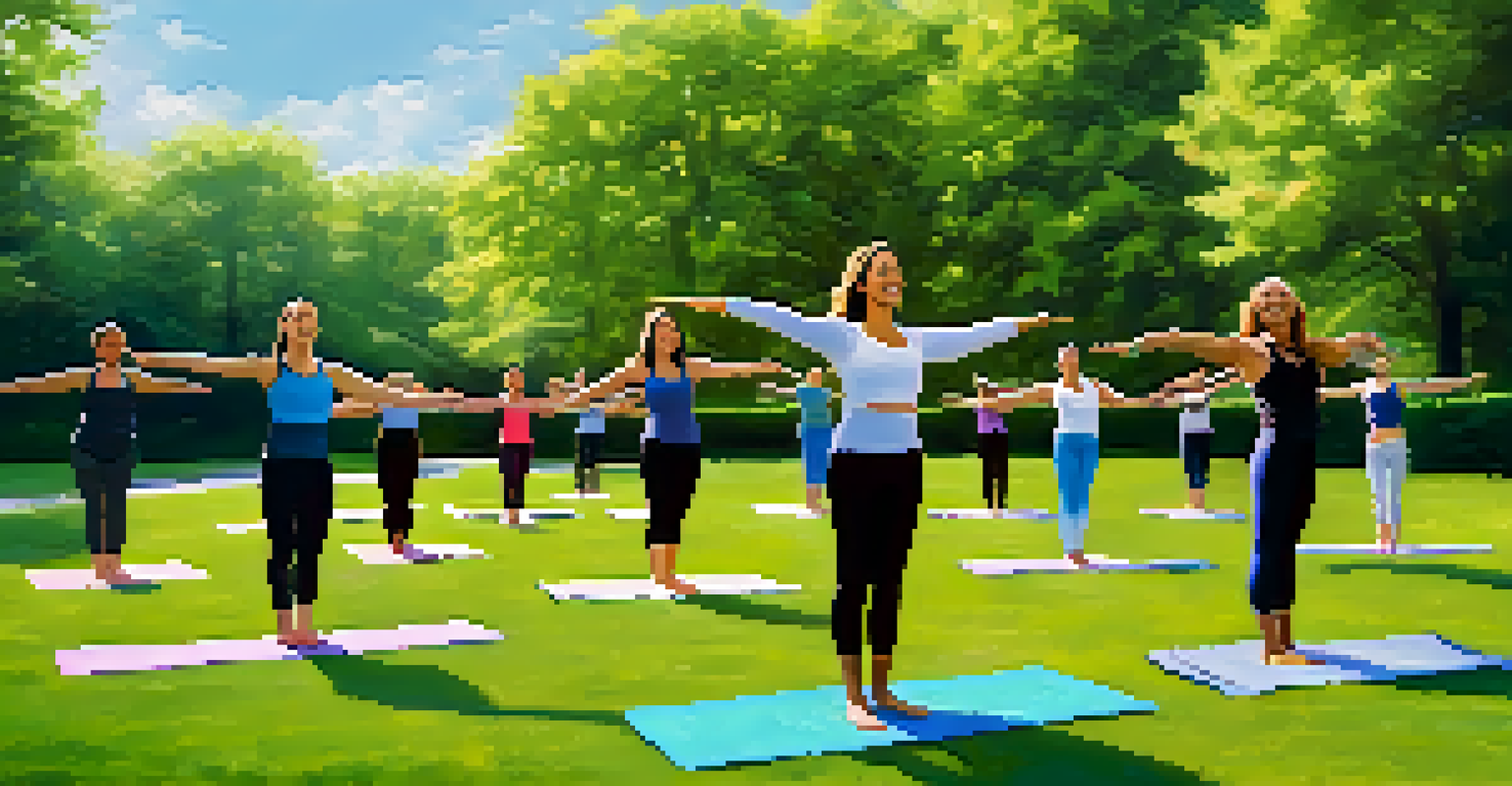Incorporating Yoga into Team Activities for Better Trust

Understanding the Benefits of Yoga for Teams
Yoga is not just a physical practice; it’s a holistic approach to well-being that can greatly benefit teams. By encouraging mindfulness and relaxation, yoga helps reduce stress, allowing team members to focus better on their tasks. This mental clarity fosters an environment where creativity can thrive, leading to more innovative solutions.
Yoga is the journey of the self, through the self, to the self.
Moreover, incorporating yoga into team activities can enhance emotional resilience. When team members practice yoga together, they learn to support each other through challenges, building a stronger bond. This shared experience creates a sense of camaraderie that can translate into improved collaboration in the workplace.
Lastly, yoga promotes physical health, which is crucial for maintaining high energy levels. Healthier employees are generally more productive and engaged, which directly impacts team dynamics. By prioritizing well-being through yoga, teams can cultivate a more positive and effective work environment.
Creating a Welcoming Yoga Environment
To successfully incorporate yoga into team activities, it’s essential to create a welcoming environment. This can start with a designated space that is quiet and free from distractions. Consider using calming colors and comfortable mats to make the area inviting and conducive to relaxation.

Additionally, it’s important to foster an atmosphere of inclusivity. Team members should feel encouraged to participate, regardless of their level of experience with yoga. A beginner-friendly approach, where everyone can learn at their own pace, can help alleviate any apprehensions and promote a sense of belonging.
Yoga Enhances Team Collaboration
Practicing yoga together fosters emotional resilience and strengthens bonds among team members, leading to improved collaboration.
Lastly, consider incorporating elements of fun and creativity into the practice. This could involve themed yoga sessions or pairing yoga with team-building exercises. Engaging everyone in a light-hearted manner can enhance the overall experience and make it more memorable.
Incorporating Mindfulness into Team Activities
Mindfulness is a key component of yoga that can be integrated into team activities. By encouraging team members to focus on their breath and present moment, mindfulness can improve concentration and reduce anxiety. This practice allows individuals to engage more fully with their teammates, fostering deeper connections.
The mind is everything. What you think you become.
You can start small by incorporating short mindfulness exercises into team meetings or activities. Simple techniques like guided breathing or a few minutes of silent reflection can set a positive tone. Over time, these practices can help shift team dynamics, leading to more open communication and collaboration.
As team members become more attuned to their own thoughts and feelings, they may also become more empathetic towards others. This increased emotional awareness can enhance trust among team members, as they learn to communicate more effectively and support one another.
Team-Building Through Partner Yoga
Partner yoga is an engaging way to build trust and teamwork among colleagues. By practicing yoga poses that require partners to work together, team members can learn to rely on one another, both physically and emotionally. This kind of collaboration fosters a deeper sense of trust that can extend into everyday work interactions.
For example, simple poses like the double tree pose or back-to-back seated poses encourage communication and teamwork. As partners assist each other in maintaining balance, they also engage in problem-solving and support, reinforcing their connection. This shared effort can lead to laughter and bonding, creating a relaxed atmosphere.
Creating an Inclusive Yoga Space
A welcoming environment that encourages participation from all experience levels promotes a sense of belonging during team yoga activities.
Moreover, partner yoga can help break down barriers, especially in teams with different personality types or backgrounds. Engaging in physical activity together can lead to better understanding and appreciation of each other’s strengths and weaknesses, which is essential for building a cohesive team.
Setting Goals for Team Yoga Sessions
Setting clear goals for yoga sessions can enhance their effectiveness and impact. Before starting, discuss what you want to achieve as a team, whether it's improved trust, communication, or stress relief. Having shared objectives helps everyone stay focused and motivated during the practice.
Consider creating specific themes for each yoga session, such as 'trust-building' or 'stress relief.' This not only keeps the activities fresh but also allows team members to reflect on the progress they are making toward their goals. It can also encourage open discussions about experiences and feelings, leading to more profound connections.
Finally, keep track of progress over time. This could be as simple as having a discussion after each session about what worked well and what could be improved. Regularly revisiting goals ensures that the team remains aligned and continues to benefit from the practice.
Addressing Challenges in Team Yoga Activities
While incorporating yoga into team activities can be rewarding, it's essential to address potential challenges. One common hurdle is varying levels of fitness and flexibility among team members. To overcome this, always offer modifications for poses, ensuring everyone feels comfortable and included.
Another challenge could be skepticism or resistance from some team members. It’s important to create a supportive environment where everyone feels safe expressing their concerns. Sharing the benefits of yoga and possibly even having a few team members share their positive experiences can help ease apprehension.
Setting Goals Boosts Yoga Effectiveness
Establishing clear objectives for yoga sessions helps teams stay focused and motivated, enhancing the overall impact of the practice.
Lastly, consistency is key. If team members only practice yoga occasionally, they may not see the benefits. Establishing a regular schedule for yoga sessions can help embed this practice into the team culture, ultimately leading to greater trust and collaboration.
Measuring the Impact of Yoga on Team Trust
To truly understand the benefits of incorporating yoga into team activities, measuring its impact is crucial. Surveys and feedback sessions can be effective tools for gathering insights on how team members feel before and after participating in yoga. This data can help identify areas of improvement and highlight successes.
Another method is to observe changes in team dynamics over time. Are team members communicating more openly? Do they seem more collaborative? Taking note of these qualitative changes can provide valuable indicators of how yoga is influencing trust within the team.

Ultimately, measuring the impact of yoga not only validates the practice but also demonstrates its value to the organization. By showcasing improvements in trust and collaboration, teams can build a strong case for the continued integration of yoga into their activities.